Claudia Clopath Lab
@clopathlab.bsky.social
Professor in Computational Neuroscience at Imperial College London
We were asked to write a commentary on NeuroAI for Nat. Rev. Neuro. with Sadra Sadeh, so here it is: www.nature.com/articles/s41...
www.nature.com
August 8, 2025 at 10:31 AM
We were asked to write a commentary on NeuroAI for Nat. Rev. Neuro. with Sadra Sadeh, so here it is: www.nature.com/articles/s41...
Trying to train RNNs in a biol plausible (local) way? Well, try our new method using predictive alignment. Paper just out in Nat. Com. Toshitake Asabuki deserves all the credit!
www.nature.com/articles/s41...
www.nature.com/articles/s41...
www.nature.com
July 23, 2025 at 12:10 PM
Trying to train RNNs in a biol plausible (local) way? Well, try our new method using predictive alignment. Paper just out in Nat. Com. Toshitake Asabuki deserves all the credit!
www.nature.com/articles/s41...
www.nature.com/articles/s41...
Are predictions computed hierarchically, or can they be computed locally? Check out our paper! Congrats, Toshitake Asabuki and @colleenjg.bsky.social !
www.pnas.org/doi/10.1073/...
www.pnas.org/doi/10.1073/...
PNAS
Proceedings of the National Academy of Sciences (PNAS), a peer reviewed journal of the National Academy of Sciences (NAS) - an authoritative source of high-impact, original research that broadly spans...
www.pnas.org
July 2, 2025 at 8:31 AM
Are predictions computed hierarchically, or can they be computed locally? Check out our paper! Congrats, Toshitake Asabuki and @colleenjg.bsky.social !
www.pnas.org/doi/10.1073/...
www.pnas.org/doi/10.1073/...
Check out our new paper how to embed state transitions in recurrent networks. Well done Toshitake Asabuki!
elifesciences.org/articles/95243
elifesciences.org/articles/95243

Embedding stochastic dynamics of the environment in spontaneous activity by prediction-based plasticity
A computational model shows how synaptic plasticity shapes spontaneous activity to encode the transition statistics of sensory experience.
elifesciences.org
June 12, 2025 at 7:12 PM
Check out our new paper how to embed state transitions in recurrent networks. Well done Toshitake Asabuki!
elifesciences.org/articles/95243
elifesciences.org/articles/95243
Check out our new work on in context learning! With @jessegeerts.bsky.social @neurokim.bsky.social @scychan.bsky.social
🧠 How do transformers learn relational reasoning? We trained small transformers on transitive inference (if A>B and B>C, then A>C) and discovered striking differences between learning paradigms. Our latest work reveals when and why AI systems generalize beyond training data 🤖
June 9, 2025 at 10:00 AM
Check out our new work on in context learning! With @jessegeerts.bsky.social @neurokim.bsky.social @scychan.bsky.social
Reposted by Claudia Clopath Lab
We're launching the data collection phase of the Community Predictive Processing project now that our plans have been published on arXiv 👉 arxiv.org/abs/2504.09614
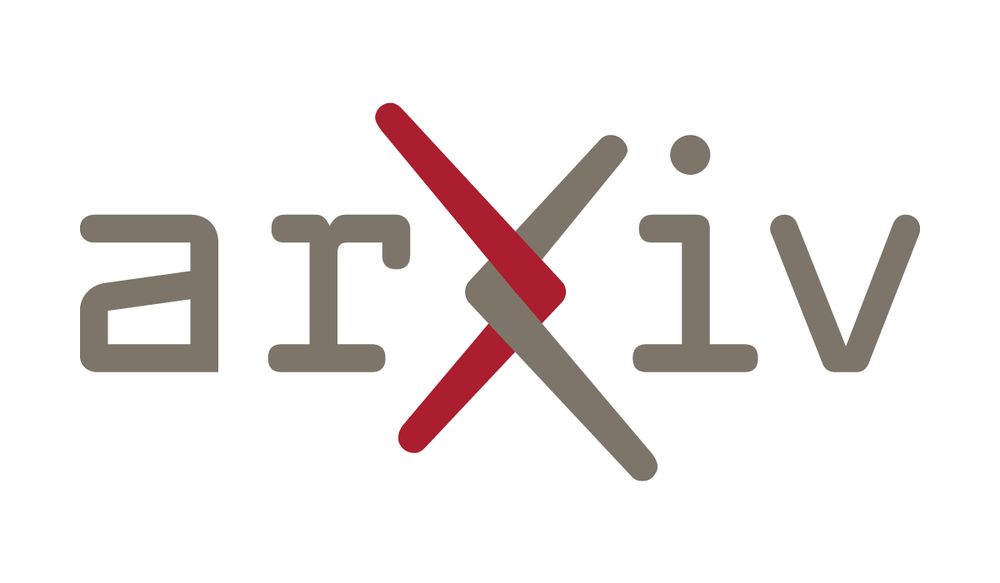
Neural mechanisms of predictive processing: a collaborative community experiment through the OpenScope program
This review synthesizes advances in predictive processing within the sensory cortex. Predictive processing theorizes that the brain continuously predicts sensory inputs, refining neuronal responses…
arxiv.org
April 22, 2025 at 9:29 PM
We're launching the data collection phase of the Community Predictive Processing project now that our plans have been published on arXiv 👉 arxiv.org/abs/2504.09614
How should you combine sensory inputs with your internal predictions? Well, use uncertainty directly computed by your prediction-error circuits. Cool? Check out our Nat. Com. paper with Loreen Hertäg and @k47h4.bsky.social . www.nature.com/articles/s41...
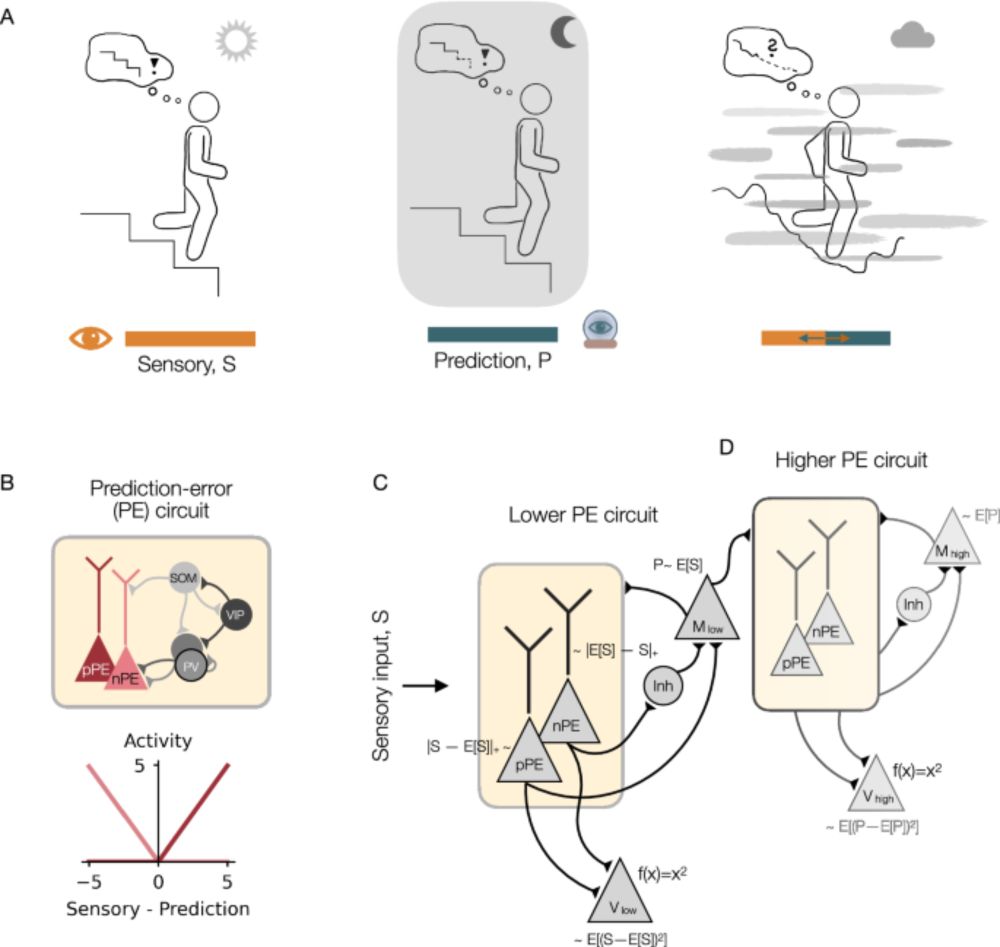
Uncertainty estimation with prediction-error circuits - Nature Communications
How the brain integrates sensory input and predictions to adapt to change is not fully understood. Here authors build a neural network model to show how prediction-error neurons compute uncertainty of...
www.nature.com
March 28, 2025 at 12:59 PM
How should you combine sensory inputs with your internal predictions? Well, use uncertainty directly computed by your prediction-error circuits. Cool? Check out our Nat. Com. paper with Loreen Hertäg and @k47h4.bsky.social . www.nature.com/articles/s41...
The Clopath Lab has a fully funded PhD position open for Oct in Computational Neuroscience at Imperial College London. If you are interested, just send us an informal e-mail!
March 20, 2025 at 9:50 AM
The Clopath Lab has a fully funded PhD position open for Oct in Computational Neuroscience at Imperial College London. If you are interested, just send us an informal e-mail!
Check out our new method to optimize neural representations from behaviour!
“SIMPL: Scalable and hassle-free optimisation of neural representations from behaviour”
openreview.net/forum?id=9kF...
From @tomnotgeorge.bsky.social Pierre Glaser, Kim Stachenfeld, @caswell.bsky.social @clopathlab.bsky.social
openreview.net/forum?id=9kF...
From @tomnotgeorge.bsky.social Pierre Glaser, Kim Stachenfeld, @caswell.bsky.social @clopathlab.bsky.social

SIMPL: Scalable and hassle-free optimisation of neural...
Neural activity in the brain is known to encode low-dimensional, time-evolving, behaviour-related variables. A long-standing goal of neural data analysis has been to identify these variables and...
openreview.net
March 17, 2025 at 4:11 PM
Check out our new method to optimize neural representations from behaviour!
Want to hear more about how feedback can guide learning in RNNs for motor adaptation. Here is our new paper in Nat. Com. with Barbara Feulner and @juangallego.bsky.social www.nature.com/articles/s41...

A neural implementation model of feedback-based motor learning - Nature Communications
How the brain adapts our movements to new conditions remains unclear. Here, the authors show that a recurrent neural network that controls its output using error-based feedback can learn to count...
www.nature.com
February 21, 2025 at 4:51 PM
Want to hear more about how feedback can guide learning in RNNs for motor adaptation. Here is our new paper in Nat. Com. with Barbara Feulner and @juangallego.bsky.social www.nature.com/articles/s41...
Check out our new paper with the Margrie lab in Cell on motor and vestibular signals in the visual cortex. Well done Mateo Velez-Fort!
Check out the full paper in @cp-cell.bsky.social from Mateo Velez-Fort, Lee Cossell, Laura Porta, @clopathlab.bsky.social and Troy Margrie
www.cell.com/cell/fulltex...
www.cell.com/cell/fulltex...

Motor and vestibular signals in the visual cortex permit the separation of self versus externally generated visual motion
Mouse primary visual cortical neurons receive running, linear translation, and visual
inputs that linearly combine to differentially represent the same visual flow information,
depending on the motion...
www.cell.com
February 21, 2025 at 4:36 PM
Check out our new paper with the Margrie lab in Cell on motor and vestibular signals in the visual cortex. Well done Mateo Velez-Fort!
Want to hear more about hippocampus-to-cortex
feedback circuit? Our paper with the Basu lab is out in Nat Neuro! rdcu.be/eak1k . Well done Tanvi Butola!
feedback circuit? Our paper with the Basu lab is out in Nat Neuro! rdcu.be/eak1k . Well done Tanvi Butola!
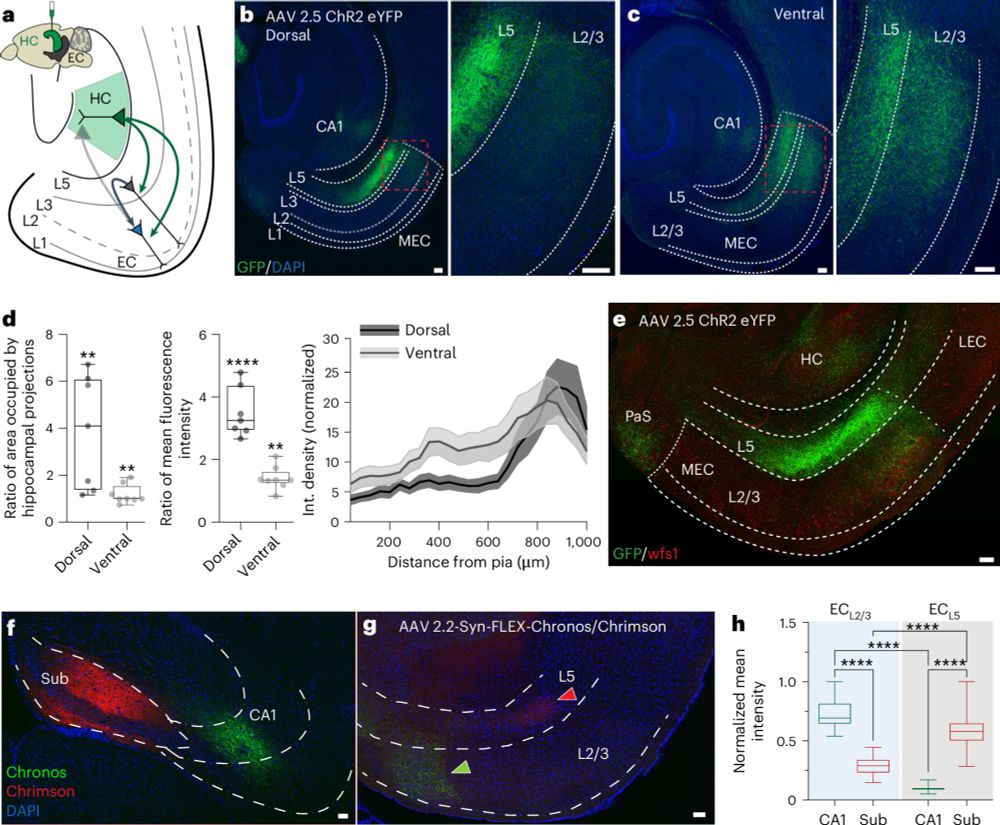
Hippocampus shapes entorhinal cortical output through a direct feedback circuit
Nature Neuroscience - Distinct hippocampal feedback pathways to deep and superficial layers of the cortex in mice differentially modulate excitation–inhibition dynamics, plasticity and...
rdcu.be
February 18, 2025 at 4:04 PM
Want to hear more about hippocampus-to-cortex
feedback circuit? Our paper with the Basu lab is out in Nat Neuro! rdcu.be/eak1k . Well done Tanvi Butola!
feedback circuit? Our paper with the Basu lab is out in Nat Neuro! rdcu.be/eak1k . Well done Tanvi Butola!
Reposted by Claudia Clopath Lab
Read the full paper in @science.org from Sara Mederos, Patty Blakely, @nicolevissers1.bsky.social @clopathlab.bsky.social and @sonjahofer.bsky.social ⬇️
www.science.org/doi/10.1126/...
www.science.org/doi/10.1126/...
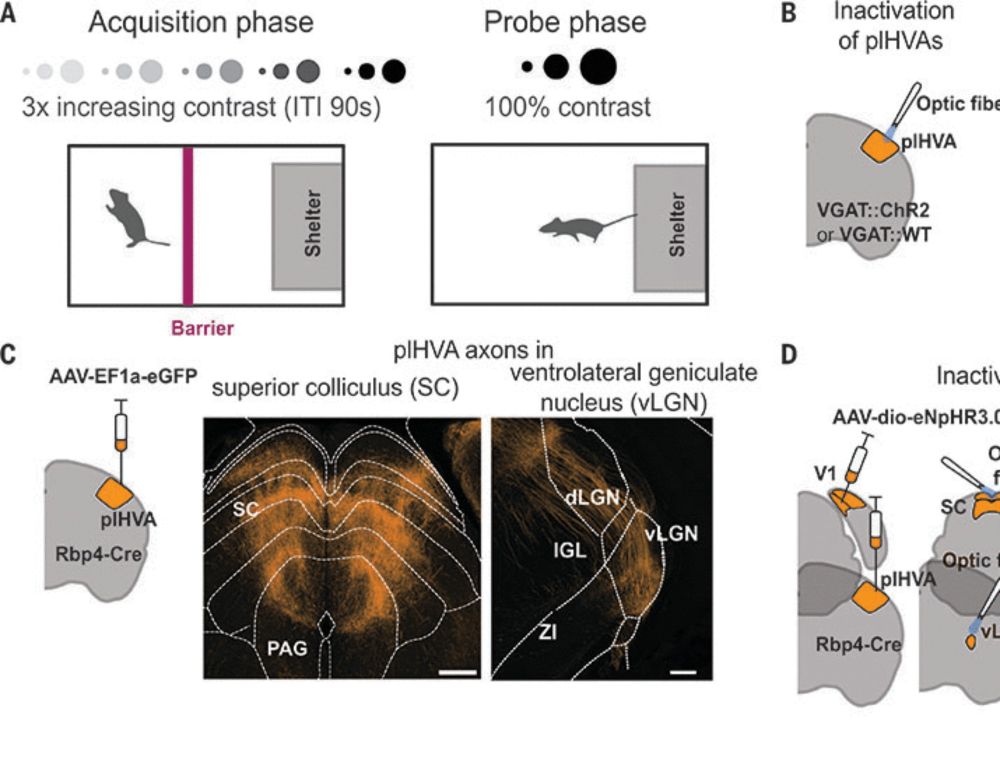
Overwriting an instinct: Visual cortex instructs learning to suppress fear responses
Fast instinctive responses to environmental stimuli can be crucial for survival but are not always optimal. Animals can adapt their behavior and suppress instinctive reactions, but the neural pathways...
www.science.org
February 6, 2025 at 7:06 PM
Read the full paper in @science.org from Sara Mederos, Patty Blakely, @nicolevissers1.bsky.social @clopathlab.bsky.social and @sonjahofer.bsky.social ⬇️
www.science.org/doi/10.1126/...
www.science.org/doi/10.1126/...
See our new paper in Science with the Hofer lab. Well done Sara Mederos!
So excited to see this out, heroic effort by the brilliant Sara Mederos, uncovering the detailed brain mechanisms of how animals learn to overcome their instinctive fear responses, from neural circuits & cell types down to synaptic plasticity mechanism! www.science.org/doi/10.1126/...
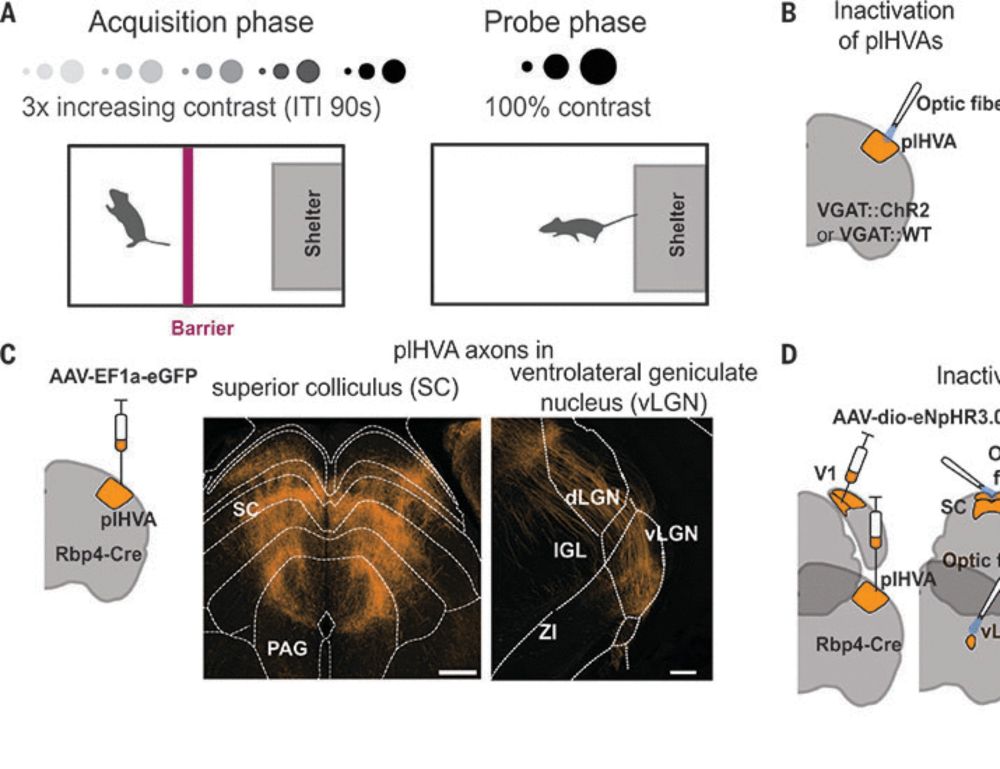
Overwriting an instinct: Visual cortex instructs learning to suppress fear responses
Fast instinctive responses to environmental stimuli can be crucial for survival but are not always optimal. Animals can adapt their behavior and suppress instinctive reactions, but the neural pathways...
www.science.org
February 7, 2025 at 3:40 PM
See our new paper in Science with the Hofer lab. Well done Sara Mederos!
Reposted by Claudia Clopath Lab
So excited to see this out, heroic effort by the brilliant Sara Mederos, uncovering the detailed brain mechanisms of how animals learn to overcome their instinctive fear responses, from neural circuits & cell types down to synaptic plasticity mechanism! www.science.org/doi/10.1126/...

Overwriting an instinct: Visual cortex instructs learning to suppress fear responses
Fast instinctive responses to environmental stimuli can be crucial for survival but are not always optimal. Animals can adapt their behavior and suppress instinctive reactions, but the neural pathways...
www.science.org
February 7, 2025 at 9:24 AM
So excited to see this out, heroic effort by the brilliant Sara Mederos, uncovering the detailed brain mechanisms of how animals learn to overcome their instinctive fear responses, from neural circuits & cell types down to synaptic plasticity mechanism! www.science.org/doi/10.1126/...
Reposted by Claudia Clopath Lab
Happy to see three computational neuroscience awards among the ERC Consolidator grants announced today, and even more impressively 3/3 are women: @clopathlab.bsky.social, @gjorjulijana.bsky.social and Alex Cayco-Gajic
All top researchers, delighted for them. Congrats
erc.europa.eu/sites/defaul...
All top researchers, delighted for them. Congrats
erc.europa.eu/sites/defaul...
erc.europa.eu
December 3, 2024 at 12:55 PM
Happy to see three computational neuroscience awards among the ERC Consolidator grants announced today, and even more impressively 3/3 are women: @clopathlab.bsky.social, @gjorjulijana.bsky.social and Alex Cayco-Gajic
All top researchers, delighted for them. Congrats
erc.europa.eu/sites/defaul...
All top researchers, delighted for them. Congrats
erc.europa.eu/sites/defaul...
Very grateful for ERC to fund my research for the next 5 years!
erc.europa.eu/news-events/...
erc.europa.eu/news-events/...

Consolidator Grants: ERC awards €678m in grants to back excellent research across Europe
The European Research Council (ERC) has awarded its 2024 Consolidator Grants to 328 researchers across Europe. These grants, totalling €678 million, aim to support outstanding scientists and scholars ...
erc.europa.eu
December 4, 2024 at 2:08 PM
Very grateful for ERC to fund my research for the next 5 years!
erc.europa.eu/news-events/...
erc.europa.eu/news-events/...
Reposted by Claudia Clopath Lab
What are the brain’s “real” tuning curves?
Our new preprint "SIMPL: Scalable and hassle-free optimisation of neural representations from behaviour” argues that existing techniques for latent variable discovery are lacking.
We suggest a much simpl-er way to do things.
1/21🧵
Our new preprint "SIMPL: Scalable and hassle-free optimisation of neural representations from behaviour” argues that existing techniques for latent variable discovery are lacking.
We suggest a much simpl-er way to do things.
1/21🧵
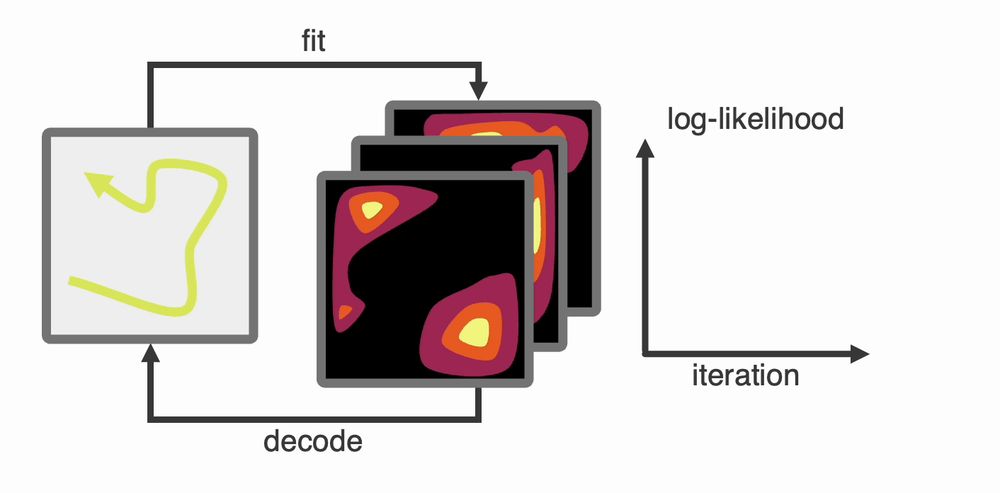
November 25, 2024 at 1:39 PM
What are the brain’s “real” tuning curves?
Our new preprint "SIMPL: Scalable and hassle-free optimisation of neural representations from behaviour” argues that existing techniques for latent variable discovery are lacking.
We suggest a much simpl-er way to do things.
1/21🧵
Our new preprint "SIMPL: Scalable and hassle-free optimisation of neural representations from behaviour” argues that existing techniques for latent variable discovery are lacking.
We suggest a much simpl-er way to do things.
1/21🧵
Reposted by Claudia Clopath Lab
This paper from Claudia Clopath's lab is very exciting for me.
I've been musing for a while now that the challenge of approximating gradient descent is probably made way easier in the brain by feedback signals for control.
Here they show it!!!
openreview.net/forum?id=xav...
🧠📈 #NeuroAI 🧪
I've been musing for a while now that the challenge of approximating gradient descent is probably made way easier in the brain by feedback signals for control.
Here they show it!!!
openreview.net/forum?id=xav...
🧠📈 #NeuroAI 🧪

Feedback control guides credit assignment in recurrent neural networks
How do brain circuits learn to generate behaviour?
While significant strides have been made in understanding learning in artificial neural networks, applying this knowledge to biological networks...
openreview.net
November 13, 2024 at 7:19 PM
This paper from Claudia Clopath's lab is very exciting for me.
I've been musing for a while now that the challenge of approximating gradient descent is probably made way easier in the brain by feedback signals for control.
Here they show it!!!
openreview.net/forum?id=xav...
🧠📈 #NeuroAI 🧪
I've been musing for a while now that the challenge of approximating gradient descent is probably made way easier in the brain by feedback signals for control.
Here they show it!!!
openreview.net/forum?id=xav...
🧠📈 #NeuroAI 🧪

